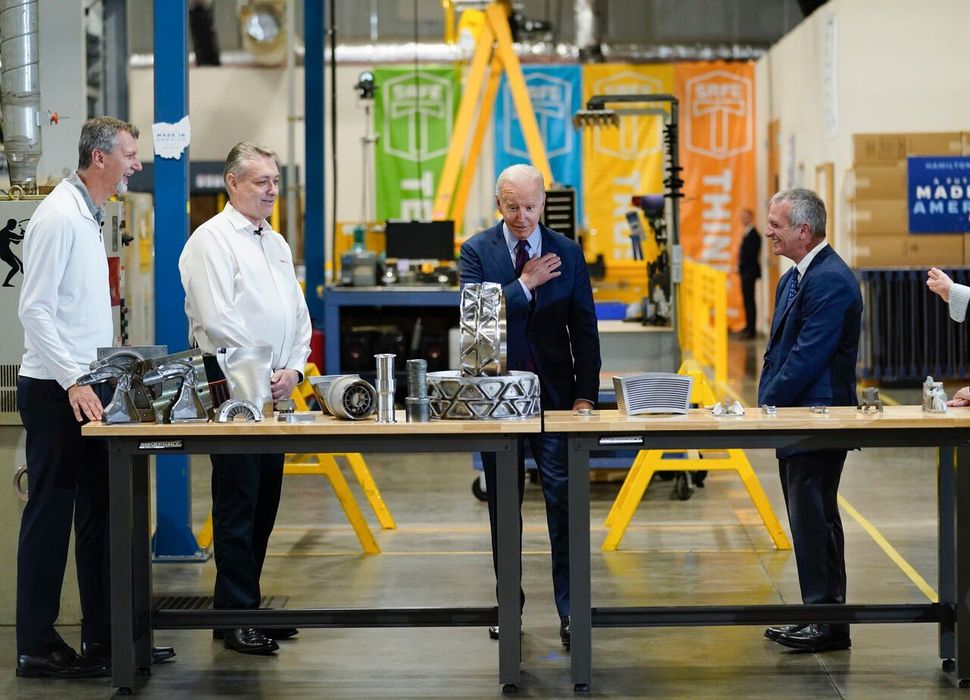
What is “AM Forward” all about and will it work?
US President Biden announced a new program, “AM Forward” to boost innovation and specifically additive manufacturing. The program is a voluntary pact between multiple notable manufacturers in the US with intentions of increasing the use of additive manufacturing technologies.
Biden’s big challenge is to get the US economy moving forward as the pandemic wanes. While the biological elements of the pandemic are slowing dissipating, there are lingering economic effects, not the least of which is the supply chain catastrophe.
During the pandemic factory shutdowns essentially blew up the concept of cheap offshore manufacturing. That concept, which has grown for decades, collapsed when the shipping systems failed due to an imbalance of traffic caused by the pandemic. As a result of this collapse, many manufacturers suddenly found themselves short of the components necessary to build their products.
Some forward-thinking companies sought a solution through additive manufacturing, which can easily produce parts without the need for setting up a complex production line. However, the cost of those parts can be somewhat higher than the usual mass produced versions. On the other hand, the cost is irrelevant if you can’t get them from overseas at any price.
This has led to a bit of a boom in 3D printing.
But it hasn’t quite made it everywhere, because getting into additive is a tricky business, particularly for smaller manufacturers that might not have the resources of larger companies. The transformation of processes to additive is much more than than simply buying some equipment and pressing “Print”. It involves changing workflows, costing, materials, and most importantly, design.
There are plenty of designers in the manufacturing world, but far fewer that have experience designing parts that can be 3D printed. That takes training and experience to do properly, and the practice even has an acronym: DfAM, Design for Additive Manufacturing.
While an increasing number of manufacturers likely want to (or should) get into additive, they face a considerable barrier as the number of DfAM-trained people is certainly insufficient.
It seems that the new AM Forward pact could help a great deal with this barrier. It’s aim is to create more resilient supply chains through investment in small manufacturers — which typically supply larger manufacturers. The pact also intends on investing in regional manufacturing ecosystems, and in particular fix the DfAM shortage. The White House fact sheet said they wish to ensure:
“Growing industries of the future, overcoming coordination challenges that limit adoption of new technologies like additive manufacturing.”
And:
“But not enough American companies are using 3D printing or other high-performance production technologies. That’s why President Biden is pleased to join several leading American companies to celebrate the launch Additive Manufacturing Forward (AM Forward), a voluntary compact between large, iconic manufacturers and their smaller U.S.-based suppliers. GE Aviation, Honeywell, Lockheed Martin, Raytheon, and Siemens Energy are the initial participants in AM Forward. These leading manufacturers will support their U.S.-based suppliers’ adoption of new additive capabilities, helping to transform shop floors across the country.”
The idea is that participating companies will commit to purchasing AM parts from smaller suppliers, thus creating a demand for regional AM activity, including training. They will also provide “detailed technical assistance” to these suppliers.
At an event at United Performance Metals in Hamilton, Ohio, US President Biden said:
“But here’s the deal: 3D printing technology — 3D printing technology is incredible. It can reduce the parts lead times by as much as 90 percent — not always, but as much as 90 percent — slash material cost by 90 percent, and cut energy use in half.”
This could be the first time a US president has promoted the technology, marking a milestone in the decades following the introduction of 3D printing in the 1980s. With this statement, Biden essentially anoints the technology as a key element of the future US economy, and by extension, the rest of the planet.
This development has certainly stirred energy in the 3D print community, as it is a huge breakthrough that could set the course for very big things in the future. That energy carries right down the individual, as metal 3D print expert SJ Jones (@inconelle) said:
Carbon’s CEO Ellen Kullman said:
“The AM Forward program is further validation of the urgent need to rebuild agile manufacturing capabilities in the U.S. We’re at an undeniable inflection point — bringing digital manufacturing to U.S. businesses will be a critical component to the success of the American economy both now and into the future. Carbon has proven how additive manufacturing can help companies like Ford, adidas, and Becton Dickinson innovate and bring products to market quickly and efficiently. The administration’s acknowledgment of 3D printing to boost the economy is a solid step forward and a proof point that digital manufacturing is critical in addressing our ongoing supply chain challenges and beyond.”
My thought is that this moment could eventually be seen as the turning point where the large move towards additive manufacturing began. While it will certainly trigger plenty of immediate action in the US manufacturing sector, it will also supercharge developments in 3D printing for years to come as the far larger set of AM manufacturers will demand even better AM technologies.
Via Whitehouse
